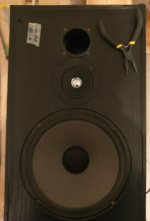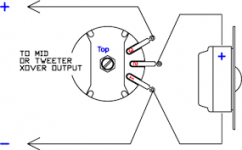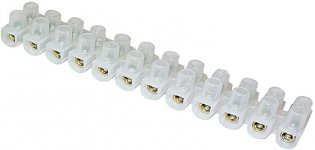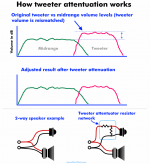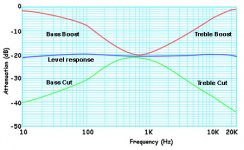But good. Moving the speakers away from the middle is a basis for compromise, even though many choose to go down that road. Keeping them in the middle and rounding the edges is a good option.I suggested symmetry simply on the grounds of simplicity and so as not to involve any mathematics!
Ok, so respecting the "cheap, cheerful and easy" sentiment, simple centered alignment it is!..I suggested symmetry simply on the grounds of simplicity and so as not to involve any mathematics!
Oh shoot, I dont recall seeing that 3.9uf change, sorryP.S. ... I actually changed my suggestion to 3.9uF to go a little lower, but you overlooked that change! No matter, 3.3uF should do, particularly if we have to attenuate the tweeter with a resistor.
Yeah I saw that, and more or less that image was what I was thinking of doing (except the proximity detail); it would be great cause I would have a bit more freedom with dimensions. I was checking the link you shared to see if I should put it that close, but I just noticed something when reading, it talks about the distance between tweeter and mid, not woofer. So my first impression was to stick it as close as possible since in the table on your link says @5000 the distance should be within 6.8cm, but the radius of my woofer alone is 9cm and the distance between centers would be ~15cm; so now my second impresion is that there is a different rule for woofer->mid/high. If its too much bugging you, maybe another helpful link would be good? (im looking for something online meanwhile too).Note also how close the tweeter is to the woofer in the attachment.
Last edited:
There will be little difference between a 3.3 and a 3.9 in this application. Besides, the original mids in your Sanyo SS-60 speakers had only 2.2uF in series (and the tweeter only 1uF)!
Remember that "1 tweeter and 1 mid (from separate speakers)" didn't work and so my mission has been to bring your broken Sanyos back to working order while remaining as faithful as possible to the original design.
Let's see how the drivers sound in the original cabinets before getting carried away with designing new boxes for them.
I don't intend to discuss enclosure design any further. As you've hinted, this is a whole new topic in itself, and you seem to be researching it well. Just get the mid/tweeter close to the woofer, however they don't have to touch.
Please consider that, given the effort and cost of building smart new enclosures, incorporating better drivers than those you currently have may be more appropriate.
Remember that "1 tweeter and 1 mid (from separate speakers)" didn't work and so my mission has been to bring your broken Sanyos back to working order while remaining as faithful as possible to the original design.
Let's see how the drivers sound in the original cabinets before getting carried away with designing new boxes for them.
I don't intend to discuss enclosure design any further. As you've hinted, this is a whole new topic in itself, and you seem to be researching it well. Just get the mid/tweeter close to the woofer, however they don't have to touch.
Please consider that, given the effort and cost of building smart new enclosures, incorporating better drivers than those you currently have may be more appropriate.
Hi Galu! Something came up yesterday and couldn't hook them up but today I did one and tomorrow I'll finish up and test them 
Ok, so if I understood, then the higher the uf the more the tweeter "contributes", as in it will take on lower frequencies; and that's why you said long ago that the old drivers were not well differentiated.. did I get that right?
 I was just clearing out a couple doubts in the meantime.
I was just clearing out a couple doubts in the meantime. 
 Granted I was happy of a little woodwork, but I wouldn't get into the box at all if not for the mold and spongy wood in the back. That's why I mentioned I'd either simply copy or take advantage of the opportunity to not have "tall" speakers and only make them a bit more "visually compact" (i.e. more depth). The spacing thing is new to me too, hence the extra questions.
Granted I was happy of a little woodwork, but I wouldn't get into the box at all if not for the mold and spongy wood in the back. That's why I mentioned I'd either simply copy or take advantage of the opportunity to not have "tall" speakers and only make them a bit more "visually compact" (i.e. more depth). The spacing thing is new to me too, hence the extra questions.
The suggestion of placing the mid/high as close as possible for wavelength reasons really helps with this "shrink" part too. Thanks!

I'll let you know how they sound tomorrow. Here is a mock-up of the speakers using the old box
There will be little difference between a 3.3 and a 3.9 in this application. Besides, the original mids in your Sanyo SS-60 speakers had only 2.2uF in series (and the tweeter only 1uF)!
Ok, so if I understood, then the higher the uf the more the tweeter "contributes", as in it will take on lower frequencies; and that's why you said long ago that the old drivers were not well differentiated.. did I get that right?
Yeah for sure. I will not bother getting into the actual woodworking unless I know it's workingLet's see how the drivers sound in the original cabinets before getting carried away with designing new boxes for them.
Yep, you and another member mentioned something similarPlease consider that, given the effort and cost of building smart new enclosures, incorporating better drivers than those you currently have may be more appropriate.
The suggestion of placing the mid/high as close as possible for wavelength reasons really helps with this "shrink" part too. Thanks!


I'll let you know how they sound tomorrow. Here is a mock-up of the speakers using the old box
Attachments
Last edited:
Yes, the higher the uF, the more the tweeter contributes. The original midrange speaker did not go low enough, which is what I meant by lack of differentiation (between mid and tweeter).
Your new Monacor driver will now do the job of both the original mid and tweeter, but more effectively. However, your ears will tell you if further component changes need to be made.
Your mock up of a new, less tall cabinet looks good.
Your new Monacor driver will now do the job of both the original mid and tweeter, but more effectively. However, your ears will tell you if further component changes need to be made.
Your mock up of a new, less tall cabinet looks good.
Thanks!Your mock up of a new, less tall cabinet looks good.
However, your ears will tell you if further component changes need to be made.
Well I have never heard these old speakers sound this good to be honest

I honestly don't understand how is it possible the woofer sounds much better now, I mean a cello sounds and vibrates as if it is right here
 If anything the woofer could be tamed a bit (jk)
If anything the woofer could be tamed a bit (jk)
The highs.. wow that's a clear sound

 .
.Although depending on the music (obviously) they highs can get a bit invasive, especially if I listen cymbal heavier music (i.e. rock, one of my favorite genres). I'm guessing part of it is different recordings; and I used CD's with a Denon audio receiver, so I don't think* its the source.
So maybe a bit of attenuation (?) might be needed... I can tame it a bit with the treble dial of course but I guess that's not the point... what would I need to get and do in order to test attenuating them a bit?
*To clarify, its not a crazy overtaking as to drive me nuts within 5 mins but it does get a bit distracting after some songs.
-----
Extended version on highs if useful. I played drums&guitar so I tend to focus more on these when listening, also I just spent close to 3hrs listening to music, solos, and stuff


-Drums: I appreciate A LOT the playful ride and hi-hats in songs with these Monacors, but the crash especially tends to take over in most rock songs, for example with Zeppelin (can't live without it so this alone carries quite a bit of weight for me), The Who, Beatles, Creedence Clearwater, Guns&Roses; even newer stuff like Audioslave, Chilipeppers, Foo Fighters and Greta Van Fleet, the crash cymbals at times are a tad too much.. and depending on the mix, at times even the hi-hats. Snares are not too punchy, just clearer.
But most songs by the Stones, Queen, Santana, Hendrik sound good; U2 is generally soft on cymbals too so no issue there, same for most of Clapton & Cream.
On Classical it was quite good. Country was ok. R&B and Blues sounded sweet and open, the highs jumped quite a bit though in some songs. A lot of people don't care much for Hip-hop and House, but on these the few highs in it definitely took over.
-Guitar: I find it overall very veeery pleasing to listen to Clapton, B.B. King and all the greats, when compared to the ol' n' busted ones (duh), and **even compared to both my B&W speakers
 . I don't notice any taking over. Only maybe at times with Santana's long held notes, or a couple Stones "mini"solos, but not too much to make me think "wtf". I actually enjoy the clarity in this sense.
. I don't notice any taking over. Only maybe at times with Santana's long held notes, or a couple Stones "mini"solos, but not too much to make me think "wtf". I actually enjoy the clarity in this sense.
Last edited:
Thanks for the comprehensive review! The results are better than I expected.
Sounds like you don't want permanent attenuation of the treble. Consequently, you are perfectly entitled to use your amplifier treble control. I use mine a lot - recordings are very variable and many need their treble to be tamed.
If you would like to include attenuation in your enclosure rebuild (should you go ahead) the most flexible method is to include a variable attenuation control (a variable L-Pad) which you can adjust as necessary, or set to what you think is a happy medium between too much and too little treble.
If you are interested in the L-Pad approach, I can supply details. I can also tell you how to permanently attenuate the tweeter - however arrivig at the exact degree of permanent attenuation required will call for some experimentation with fixed resistor values.
Sounds like you don't want permanent attenuation of the treble. Consequently, you are perfectly entitled to use your amplifier treble control. I use mine a lot - recordings are very variable and many need their treble to be tamed.
If you would like to include attenuation in your enclosure rebuild (should you go ahead) the most flexible method is to include a variable attenuation control (a variable L-Pad) which you can adjust as necessary, or set to what you think is a happy medium between too much and too little treble.
If you are interested in the L-Pad approach, I can supply details. I can also tell you how to permanently attenuate the tweeter - however arrivig at the exact degree of permanent attenuation required will call for some experimentation with fixed resistor values.
If you are desperate to experiment with attenuation, try a 3.3Ω, 5W or 10W ceramic (wire wound) resistor in series with the Monacor.
You can simply place the resistor in the negative wire going from the woofer to the Monacor - in the same way as you placed the capacitor in the positive wire.
This will provide 3dB of attenuation. At the same time, the Monacor will go a little lower in frequency - which may be a positive outcome in this case - we can but experiment! If this is too much attenuation, use a smaller value of resistor.
An L-Pad would attenuate without altering the roll-off frequency, so can be held in reserve as an alternative solution if proved necessary.
You can simply place the resistor in the negative wire going from the woofer to the Monacor - in the same way as you placed the capacitor in the positive wire.
This will provide 3dB of attenuation. At the same time, the Monacor will go a little lower in frequency - which may be a positive outcome in this case - we can but experiment! If this is too much attenuation, use a smaller value of resistor.
An L-Pad would attenuate without altering the roll-off frequency, so can be held in reserve as an alternative solution if proved necessary.
Last edited:
Yeah I was pleasantly surprised too because I did not expect much from these speakers 
Ok, good to know that its ok to play with those controls, I thought it was like cheating, I feel better about it haha
About the L-Pad that sound good to me that way I don't get "stuck" with one setting, given that I listen to many different genres. What specs should I look for with this?
that way I don't get "stuck" with one setting, given that I listen to many different genres. What specs should I look for with this?
The experimenting with resistors might be also a good idea to get my toes wet on that too .. also because if I cannot find what I need for the L-pad then at least I have a second option. When you say a resistor of smaller value, are you referring to the ohms, watts, or both? What would be the "step down"of the 3.3 ohm 5-10watts?
.. also because if I cannot find what I need for the L-pad then at least I have a second option. When you say a resistor of smaller value, are you referring to the ohms, watts, or both? What would be the "step down"of the 3.3 ohm 5-10watts?
Ok, good to know that its ok to play with those controls, I thought it was like cheating, I feel better about it haha
About the L-Pad that sound good to me
The experimenting with resistors might be also a good idea to get my toes wet on that too
Check out your suppliers for '8ohm L-Pad control'. They come in different wattage ratings. Let me know what you find. I'll provide wiring details in due course if necessary.
I mean a resistor of smaller resistance (ohm value) than 3.3ohm.
3.3ohm in series would theoretically lower the roll-off point to around 4,250Hz.
I mean a resistor of smaller resistance (ohm value) than 3.3ohm.
3.3ohm in series would theoretically lower the roll-off point to around 4,250Hz.
Where have you been living all this time, under a rock?Ok cool, sounds simple enough, thanks!!Had to google what was twin flex hahaha
EVERYBODY knows what Twin Flex means!
Twin contortions| CCTV English - YouTube
Ok cool, thanks! I will look for these in the coming days. Stores are opening slowly here so it might take me a couple days (unless I find it online before).
So dumb question: is the treble knob doing a similar same thing as the L-pad? I'm guessing its not doing like the resistor that lowers the roll-off a bit as-well as attenuating? I ask maybe because if playing with the treble gives me the same as the L-pad then maybe I can just experiment with the resistor. Sorry if its too silly of a question, just trying to understand the differences
About testing these components, how would you recommend that I connect these things for testing? By soldering on and off every time or is there some handy gadget/clamp/something that will fasten-unfasten things easier for testing and moving around? I used electrical tape but it sticks somewhat flimsy given the very thin connections.
So dumb question: is the treble knob doing a similar same thing as the L-pad? I'm guessing its not doing like the resistor that lowers the roll-off a bit as-well as attenuating? I ask maybe because if playing with the treble gives me the same as the L-pad then maybe I can just experiment with the resistor. Sorry if its too silly of a question, just trying to understand the differences

About testing these components, how would you recommend that I connect these things for testing? By soldering on and off every time or is there some handy gadget/clamp/something that will fasten-unfasten things easier for testing and moving around? I used electrical tape but it sticks somewhat flimsy given the very thin connections.
No. An L-Pad will reduce all the frequencies being reproduced by the tweeter by the same amount. A treble control progressively rolls off the higher frequencies more than the lower ones.So dumb question: is the treble knob doing a similar same thing as the L-pad?
About testing these components, how would you recommend that I connect these things for testing?
For quick, experimental connection of components, you can use individual sections of terminal strip.
Attachments
Thanks for the clarification!No. An L-Pad will reduce all the frequencies being reproduced by the tweeter by the same amount. A treble control progressively rolls off the higher frequencies more than the lower ones.
For quick, experimental connection of components, you can use individual sections of terminal strip.
Genius! and I have plenty in my mini-workshed... somewhere...
Pictures are worth a thousand words, but at the risk of generating more questions!
Yep that did the trick!


And yes one small question for now.. I still have to wire things up as per the first diagram you sent me right?

- Status
- This old topic is closed. If you want to reopen this topic, contact a moderator using the "Report Post" button.
- Home
- Design & Build
- Construction Tips
- Help needed to Fix or Repurpose old Speakers
